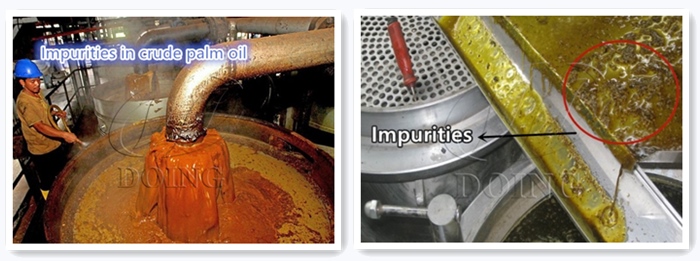

What impurities are there in crude vegetable oil and how to remove?
FAQ / Chat on line / Give me a price / Date:March 19, 2019
After oil pressing, we can get crude vegetable oil. However, usually there are a few impurities and harmful substances in crude vegetable oil so that people cannot eat directly. Now let’s see what kinds of impurities in crude vegetable oil and how to get rid of them.
 The impurities in crude vegetable oil
The impurities in crude vegetable oil
The impurites in crude vegetable oil:
| Suspended impurities: | sediment, seed powder, cake residue |
| Peptizing impurities: | phospholipids, proteins, sugars and their lower decomposition products |
| Oil-soluble impurities: | free fatty acids (FFA), sterols, tocopherols, , fatty alcohols, waxes |
| Other impurities: | pesticides |
| Moisture | |
| Pigments |
1. Suspended impurities:
Peptizing impurities not only affect the stability of the oil, but also influence the effect of oil refining and deep processing.
In the deacidification refining process, the oil will promote emulsification, and increase the operation difficulty and the consumption of refining. Also it will reduce the quality of the soapstock.
In the process of decolorization, it will increase the consumption of twhit clay and reduce the decolorization effect.
Solution: The process of removing peptized impurities from the crude vegetable oil is called degumming.
2. Oil-soluble impurities:
There is always a certain amount of free fatty acids in vegetable fats, the amount of which depends on the quality of the crude vegetable oil. The immature nature of the seeds and the high damage of the seeds are the reason of high acid value in crude vegetable oils, especially under high moisture conditions, which are very unfavorable for oil preservation and will increase the free acid content.
Solution: The main method of deacidification is the deacidification refining process.
3. Pigments
The pigments component in vegetable oils are complex, including chlorophyll, carotene, flavonoid pigments, anthocyanidins, and decomposition products of certain sugars and proteins.
Solution: Decolorization is the way to get rid of color in crude edible oil.
4. Moisture and other impurities:
All kinds of vegetable oils have their own unique flavor and taste. After deacidification and decolorization, there are traces of aldehydes, ketones, hydrocarbons, low molecular weight fatty acids, glyceride oxides, clay and residual solvents, smell, etc.
Solution: The process of removing these bad odors is called deodorization.
5. Wax impurites:
Some crude vegetable oil contains wax. Like crude sunflower oil, crude corn germ oil, crude rice bran oil and crude cottonseed oil. These oil refining process needs add another step--dewaxing.
Solution: Dewaxing is the process to remove wax in some crude edible oil.
The technology to remove impurites in crude oil:
Our crude edible oil refining machine is designed based on the above technology solution. The edible oil refining process is as the following.
Degumming --Deacidification --Dcolorization --Deodorization --Dewaxing(dewaxing step only for sunflower, cotton,corn germ and rice bran oil).
contact us
Kindly leave your message in below form. Our engineer will contact you ASAP once we got your message.





